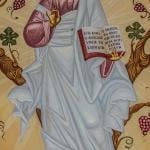The story of African American Catholicism is the story of a people who obstinately clung to a faith that gave them sustenance, even when it did not always make them welcome. Like many others, blacks had to fight for their faith; but their fight was often with members of their own household.
Mother Theresa Maxis Duchemin holds a unique place in African-American Catholic history. During the nineteenth century, she helped found two religious communities, one for white women and the other for African-American women. And she served as the leader of both.
She was born Almeide Maxis Duchemin in Baltimore to a Haitian mother and a white father who never acknowledged her. She was raised by her mother, a free woman, who worked as a nurse. In 1829, at age nineteen, Almeide became one of the founding members of the Oblate Sisters of Providence, the first religious community for African-American women. (At the start she was the only American-born member.) She took the religious name of Theresa, and later served as mother superior.
In 1831, when a cholera epidemic struck Baltimore, the Oblates helped nurse the sick. In the process Theresa’s mother, who had also joined the community, died of the disease. While the city fathers publicly thanked the white sisters for their service, they ignored the Oblates altogether. During the 1840’s, the community experienced a major crisis as ecclesiastical authorities tried to disband it. At that time Theresa, who was seven-eighths white, seems to have made a decision to no longer identify with her African-American heritage and left the Oblates. Soon thereafter she met a young Belgian priest named Louis Florent Gillet, who was looking for sisters to teach in Monroe, Michigan.
In November 1845, Sister Theresa and Father Gillet founded the Sisters, Servants of the Immaculate Heart of Mary (I.H.M.). She became the first Mother Superior (of a white community). Over the next decade, the Sisters opened several schools and orphanages in Michigan. In 1858, they were opened schools in Pennsylvania. In doing so, they incurred the wrath of Detroit’s Bishop, Peter Paul Lefevre, who used his authority to depose Mother Theresa. Lefevre knew about her racial background, and prejudice played a big part in his animosity toward her.











